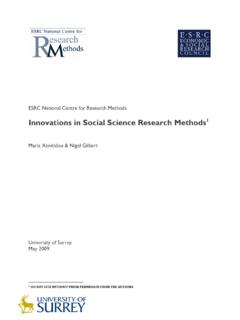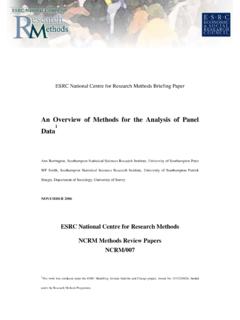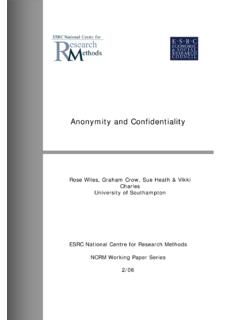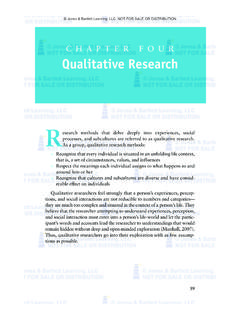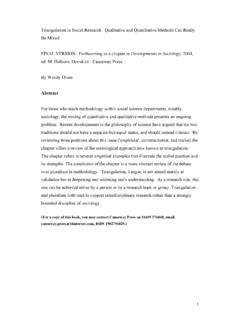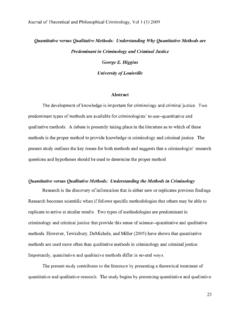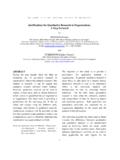Transcription of Methods for the thematic synthesis of qualitative …
1 James Thomas and Angela Harden Methods for research synthesis Node, Evidence for Policy and Practice Information and Co-ordinating (EPPI-)Centre, Social Science research Unit, 18 Woburn Square, London WC1H 0NS ESRC National Centre for research Methods NCRM Working Paper Series Number (10/07) Methods for the thematic synthesis of qualitative research in systematic reviews Author contact details Dr James Thomas Associate Director Methods for research synthesis a node of the National Centre for research Methods EPPI-Centre Social Science research Unit 18 Woburn Square London WC1H 0NS +44(0)207 612 6844 Email: Dr Angela Harden Associate Director Methods for research synthesis a node of the National Centre for research Methods EPPI-Centre Social Science research Unit 18 Woburn Square London WC1H 0NS +44(0)207 612 6246 Email.
2 1 Abstract There is a growing recognition of the value of synthesising qualitative research in the evidence base in order to facilitate effective and appropriate policy and practice. In response to this, Methods for undertaking these syntheses are currently being developed. thematic analysis is a method that is often used to analyse data in primary qualitative research . This paper reports on the use of this type of analysis in systematic reviews to bring together and integrate the findings of multiple qualitative studies. We describe the activity of thematic synthesis , outline several steps for its conduct and illustrate the process and outcome of this approach using a completed review of health promotion and public health research .
3 We compare thematic synthesis to other Methods for the synthesis of qualitative research and discuss issues of context and rigour. 2 Background The systematic review is an important technology for the evidence-informed policy and practice movement which aims to bring research closer to decision-making (Chalmers, 2003; Oakley, 2002). This type of review uses rigorous and explicit Methods to bring together the results of primary research in order to provide reliable answers to particular questions (Cooper and Hedges, 1994; EPPI-Centre, 2006; Higgins and Green, 2006; Petticrew and Roberts, 2006). The picture that is presented aims to be neither distorted by biases in the review process nor by biases in the primary research the review contains (Chalmers et al.)
4 , 2002; Juni et al., 2001; Mulrow, 1994; White, 1994). Systematic review Methods are well developed for certain types of research such as randomised controlled trials (RCTs). Methods for reviewing qualitative research in a systematic way are still emerging, and there is much ongoing development and debate ( Campbell et al., 2003; Dixon-Woods et al., 2006a; Sandelowski and Barroso, 2007; Thorne et al., 2004). In this paper we present one approach to the synthesis of findings of qualitative research which we have called thematic synthesis . We have developed and applied these Methods within several systematic reviews that address questions about people s perspectives and experiences (Harden et al.
5 , 2004; 2006; Thomas et al., 2003; 2007). The context for this methodological development is a programme of work in health promotion and public health (HP & PH), mostly funded by the English Department of Health, at the EPPI-Centre, in the Social Science research Unit at the Institute of Education, University of London in the UK. Early systematic reviews at the EPPI-Centre addressed what works? and contained research testing the effects of interventions. However, policymakers and other review users also posed questions about intervention need, appropriateness and acceptability, and factors influencing intervention implementation. To address these questions, our reviews began to include a wider range of research , including research often described as qualitative 1.
6 We began to focus, in particular, on research that aimed to understand the health issue in question from the experiences and point of view of the groups of people targeted by HP&PH interventions. When we started the work for our first series of reviews which included qualitative research in 1999 (Harden et al., 2001a,b; Rees et al., 2001; Shepherd et al., 2001), there was very little published material that described Methods for synthesising this type of research . We therefore experimented with a variety of techniques borrowed from standard systematic review Methods and Methods for analysing primary qualitative research (Harden et al., 2004). In later reviews, we were able to refine these Methods and began to apply thematic analysis in a more explicit way.
7 The Methods for thematic synthesis described in this paper have so far been used explicitly in three systematic reviews (Harden et al., 2006; Thomas et al., 2003; 2007). 1 We use the term qualitative cautiously because it encompasses a multitude of research Methods at the same time as an assumed range of epistemological positions. In practice it is often difficult to classify research as being either qualitative or quantitative as much research contains aspects of both (Bryman, 1988; Hammersley, 1992; Harden and Thomas, 2005; Oakley, 2000). Because the term is in common use, however, we will employ it in this paper.
8 3 The review used as an example in this paper To illustrate the steps involved in a thematic synthesis we draw on a review of the barriers to, and facilitators of, healthy eating amongst children aged four to 10 years old (Thomas et al., 20032). The review was commissioned by the Department of Health, England to inform policy about how to encourage children to eat healthily in the light of recent surveys highlighting that British children are eating less than half the recommended five portions of fruit and vegetables per day. While we focus on the aspects of the review that relate to qualitative studies, the review was broader than this and combined answering traditional questions of effectiveness, through reviewing controlled trials, with questions relating to children s views of healthy eating, which were answered using qualitative studies.
9 The qualitative studies were synthesised using thematic synthesis the subject of this paper. We compared the effectiveness of interventions which appeared to be in line with recommendations from the thematic synthesis with those that did not. This enabled us to see whether the understandings we had gained from the children s views helped us to explain differences in the effectiveness of different interventions: the thematic synthesis had enabled us to generate hypotheses which could be tested against the findings of the quantitative studies hypotheses that we could not have generated without the thematic synthesis . The Methods of this part of the review are published in Thomas et al.
10 (2004) and are discussed further in Harden and Thomas (2005). The review found that most interventions were based in school (though frequently with parental involvement) and often combined learning about the health benefits of fruit and vegetables with hands-on experience in the form of food preparation and taste-testing. Interventions targeted at people with particular risk factors worked better than others, and multi-component interventions that combined the promotion of physical activity with healthy eating did not work as well as those that only concentrated on healthy eating. Six main issues emerged from the studies of children's views: (1) children do not see it as their role to be interested in health; (2) children do not see messages about future health as personally relevant or credible; (3) fruit, vegetables and confectionery have very different meanings for children; (4) children actively seek ways to exercise their own choices with regard to food; (5) children value eating as a social occasion; and (6) children see the contradiction between what is promoted in theory and what adults provide in practice.


